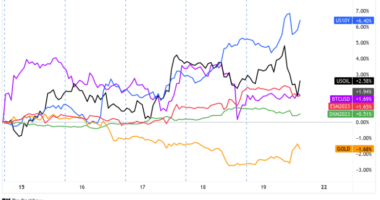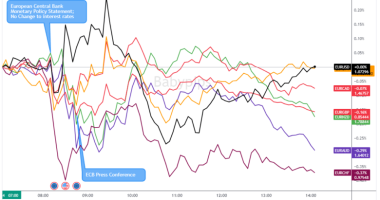It was a wild week in the financial markets as traders had to balance focus between massive crypto developments, big moves in oil prices, and potentially sentiment changing inflation news from the U.S.
Overall, it was the Dollar that saw the biggest moves in the FX space as it took the last spot among the majors thanks to U.S. CPI data.
Notable News & Economic Updates:
The U.S. Department of Justice reported on Monday that a raid on James Zhong’s home in 2021 resulted in the seizure of nearly $3.36 billion in stolen bitcoin.
Questions surrounding Alameda Research (the trading team of FTX founder/CEO Sam Bankman Fried) and a decision by Binance founder Zhao “CZ” Changpeng to sell $530M worth of FTX token, FTT, sparked a tumultuous week for crypto on Tuesday.
This week, the number of daily Covid cases in China rose to its highest level in more than six months as outbreaks spread around the country. Health officials vowed to maintain the country’s rigorous virus restrictions.
China’s consumer price inflation was up by 2.1% y/y vs. a forecast of 2.4% in October; producer prices were down by -1.3% y/y, its first decline since December 2020, due to COVID controls
On Wednesday, the National Bank of Poland maintained its benchmark interest rate at 6.75%
U.S. crude in storage jumped by 3.9M bbls in the last week to 440.8M bbls
Russian Defense Minister orders troops to leave Ukrainian city of Kherson
It was reported on Thursday that U.S. core consumer prices rose at a slower pace than expected in October at 7.7% y/y vs. 7.9% y/y forecast
Sam Bankman-Fried steps down as CEO of FTX, which filed for Chapter 11 bankruptcy in Delaware on Friday
China eases COVID quarantine time by two days to a five day quarantine and three day home observation
Intermarket Weekly Recap
It was a busy week as we had three major themes and headlines pushing the different asset classes in all kinds of directions.
We started off the week with another round of data and headlines from China signaling a potential road bump ahead for the global recovery. The first time fall in Chinese exports was certainly something to watch, but arguably, the most notable headline to influence early sentiment was the spike in COVID cases to the highest levels in six months.
Couple this with several statements from Chinese officials throughout the week reiterating that the zero-COVID policy isn’t going anywhere, and it’s likely the speculation on China fully reopening was tempered, likely supporting risk aversion behavior in the early half of the week.
This was probably best seen in the oil markets, which when coupled with the jump in oil inventory data, made for a bad week for oil bulls as prices declined roughly -8% peak to trough. And the fall in oil is likely why we saw the Loonie punished this week despite a lack of major negative catalysts from Canada.
Arguably, the bigger catalyst for risk aversion sentiment was the drama that digital asset space. It was there that we saw the rapid fall of FTX and its founder/CEO Sam Bankman-Fried (aka SBF). What started out as questions around Alameda Research’s balance sheet, then a twitter feud between Binance founder Zhao “CZ” Changpeng and Sam Bankman-Fried, which eventually turned into FTX (a $32B company last week) becoming insolvent as users tried to withdraw billions.
This week also potentially uncovered an alleged misuse of customer funds by FTX, a failed attempt by Sam Bankman-Fried to find investors to save the company, and an eventual move by SBF to file for bankruptcy and step down as CEO of FTX.
Needless to say, this is a disaster for the digital asset space, especially for the many users (both retail and institutional) who were unable to withdraw their funds from FTX. Crypto assets fell big time this week, with bitcoin hitting -24% before finding a bottom, and FTX’s FTT token falling -90% from trading around $22 on Monday.
We have yet to see the complete fallout from this event, but it’ll likely keep a lot of traders on the sidelines from crypto as we all wait to see how it all plays out.
Finally, as crazy as the drama was in crypto, the big event of the week was Twitter pausing paid verification due to user abuse. Just kidding (but who really didn’t see that coming?). The main event was the latest CPI read from the U.S. and it shook up the markets on Thursday as it came in below forecasts on both headline and core reads.
This result sparked a massive reaction across the financial markets, likely on the idea that we may be seeing the first inklings of high inflation conditions topping out, which in turn may lead the Fed to slow down their aggressive monetary policy tightening stance. We’ll see.
The U.S. dollar and bond yields dropped on the news as expected, while all USD denominated assets took off to the races to the upside. This was actually the event that pushed the Greenback into the red against all of the majors this week and solidified its spot as the biggest loser.
The biggest winner among the forex majors was the Japanese yen, followed by the Swiss franc. Given that both are considered “safe haven” currencies, it’s no surprise we saw their out performance in a week of arguably net negative headlines and data. But more likely, it was massive turn in the U.S. dollar that spurred the gains in both.
USD Pairs

Overlay of USD Pairs: 1-Hour Forex Chart
U.S. consumer credit rose by $25B in September, below the August rise of $30.2B
U.S. Small Business Optimism Index for October: -0.8 to 91.3
U.S. wholesale inventories in September: +0.6% m/m vs. +1.4% m/m in August
U.S. CPI for October: 0.4% m/m vs. 0.6% m/m forecast; core CPI came in at 0.3% m/m vs. 0.5% forecast
Weekly U.S. Unemployment claims were 225K vs. 218K the previous week
The US’s October inflation report was favorable, which Treasury Secretary Janet Yellen referred to as “a nice reading,” but she advised against placing undue reliance on just one piece of information.
The University of Michigan’s preliminary consumer sentiment index read came in at 54.7 vs. 59.9 in October. This was below the forecast of 59.5
GBP Pairs

Overlay of GBP Pairs: 1-Hour Forex Chart
Halifax: UK house prices dropped by 0.4% in October, the fastest monthly rate since February 2021
Huw Pill, the chief economist at the Bank of England, said on Tuesday that the UK’s severe decline in employment is keeping inflation high and expects more hikes in interest rates.
RICS UK house inquires index fell from -36 to -50, fastest decrease since the start of Covid in 2020
U.K. preliminary GDP read for Q3 2022: -0.2% q/q vs. +0.2% q/q preivous; this was better than an expected read of -0.5% q/q
U.K. Manufacturing Production for September: 0.0% m/m vs. -1.1% m/m in August; Construction Output rose by 0.4% m/m vs. 0.6% previous (-0.6% m/m forecast)
Bank of England policymaker Haskel implied on Friday that an economic slowdown doesn’t mean an automatic move to slow down its current tightening policy
EUR Pairs

Overlay of EUR Pairs: 1-Hour Forex Chart
Germany’s industrial production up by 0.6% m/m in September after 1.2% decline in August
According to Governing Council member Francois Villeroy de Galhau, the European Central Bank should continue raising interest rates, even at a slower rate, until inflation that excludes energy and food costs starts to decline.
In an interview with Politico released on Tuesday, ECB Vice President Luis de Guindos stated that quantitative tightening would undoubtedly begin in 2023
Euro area retail sales in September: +0.4% m/m vs. a downward revised -0.3% m/m read for August
Germany final CPI read for October 2022: +10.4% y/y and +0.9% m/m
The European Commission forecasted on Friday that the economy will contract in Q4 2022 and Q1 2023, mainly due to surging energy prices and the war in Ukraine
CHF Pairs

Overlay of CHF Pairs: 1-Hour Forex Chart
Swiss National Bank Chairman Thomas Jordan gave a hint on Tuesday that the central bank would be raising interest rates again, saying “determined action” is needed to rein in inflation.
According to Andrea Maechler, a member of the governing board, the Swiss National Bank now sees “no compelling advantage” to establishing digital central bank money for the general public.
On Friday, Swiss Nation Bank Chair Thomas Jordan said that they are prepared to take “all measures necessary” to reign in inflation back to the SNB’s 0-2% target range.
CAD Pairs

Overlay of CAD Pairs: 1-Hour Forex Chart
In a speech on Thursday, Governor Tiff Macklem claimed that the excessive tightness in the labor market reflected high demand in the economy and increased inflationary pressures.
Macklem emphasized that the central bank is attempting to weigh the risks of over- versus under-tightening financial conditions, but remained silent on the direction for interest rates.
NZD Pairs

Overlay of NZD Pairs: 1-Hour Forex Chart
New Zealand q/q inflation expectations accelerated from 3.07% to 3.62% in Q3 – RBNZ
On Tuesday, RBNZ Governor Adrian Orr was reappointed for a second five-year term, starting in March 2023
BusinessNZ manufacturing PMI slumps from 52.0 into a contractionary 49.3 in October
New Zealand’s food price increase hits 14-year high at 10.1% y/y in October
AUD Pairs

Overlay of AUD Pairs: 1-Hour Forex Chart
Australia’s AIG services index dipped from 48.0 to 47.7 in October
Australian Westpac consumer sentiment index slumped 6.9% in Nov.
Australia’s NAB business confidence index dropped from 5 to 0 in Oct.
Australia’s building permits down by 5.8% m/m in September after a 23.1% jump in August
Australia’s house approvals plunge by 7.8% m/m in September after a 4.8% increase in August
AU MI inflation expectations rise from 5.4% to 5.0% in November
JPY Pairs

Overlay of Inverted JPY Pairs: 1-Hour Forex Chart
Japanese household spending slumped from 5.1% to 2.3% y/y in Sept
Japanese leading indicators fell from 101.3% to 97.4% in Sept
Japan’s bank lending up by 2.7% y/y in October, higher than 2.3% uptick in September
Reuters Tankan manufacturing sentiment index for Japan is down from 5 to 2 in November, the lowest reading since January 2021
Japan machine tool orders fell for the first time in two years, down 5.4% y/y in October
Japan M2 Money Supply in October: +3.1% y/y vs. +3.3% y/y in September
BOJ Governor Kuroda reiterated that there was very little chance of an interest rate hike in the near-term.
Japan producer inflation jumped 9.1% y/y in October, slower than September’s 10.2% gain but above expected 8.8% increase
Japan’s Finance Minister Suzuki and head of FX Kanda watching JPY moves with a “high sense of urgency,” ready to take action if needed









